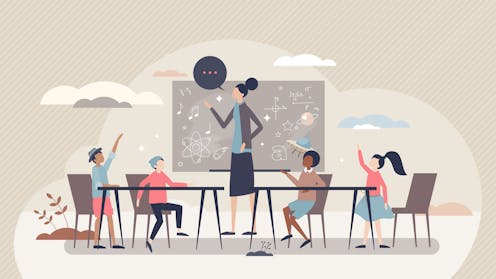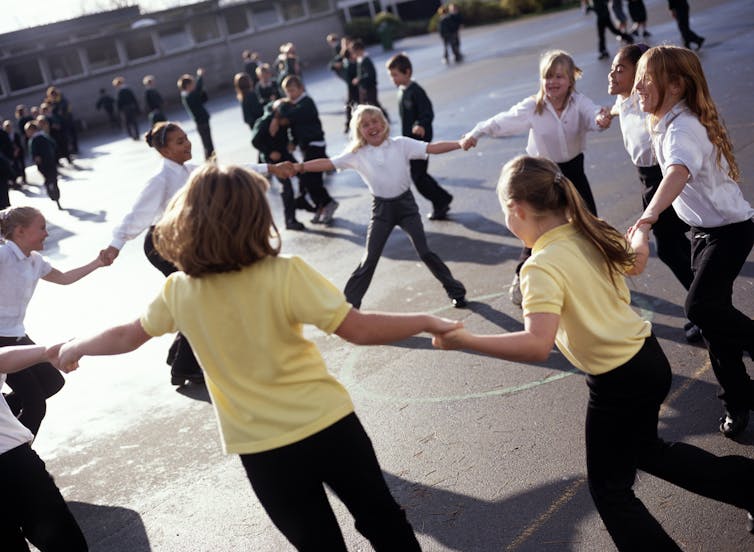Educators find creative work-arounds to new laws that restrict what they can teach
- Written by Riley Drake, Assistant Professor, University of Wisconsin-Stout
 Some educators are chafing under new laws that limit what and how they can teach.VectorMine/iStock via Getty Images Plus
Some educators are chafing under new laws that limit what and how they can teach.VectorMine/iStock via Getty Images PlusAn onslaught of executive orders from President Donald Trump aim to restrict how and what educators can teach America’s children.
Since taking office in January 2025, Trump has attempted to bar teachers from discussing racism and sexism in K-12 schools and order all schools that receive federal funding to recognize only two gender identities – male and female – potentially barring teachers from acknowledging the existence of nonbinary, gender queer and transgender people, including among their students.
Educators say the orders are having a chilling effect in classrooms, with some teachers censoring themselves by minimizing dialogue about race, gender and other topics. Other educators, however, are finding ways to resist what they see as federal intrusion into the classroom.
In March 2025, Sarah Inama, a sixth grade history teacher in Meridian, Idaho, refused to remove a classroom poster reading “Everyone is Welcome” when school district officials claimed the message was too controversial.
“There are only two opinions on this sign. Everyone is welcome here or not everyone is welcome here,” Inama said in a March 2025 interview with Today.com.
I am a scholar and former elementary school counselor. My research explores how educators act alongside young people and community organizers to challenge laws, policies and ways of controlling society that they see as harmful in schools.
In my studies, I’ve encountered some educators who have found clever ways to support their students and have difficult conversations without violating executive orders or the law.
Modeling transformative justice
The Trump administration’s restrictive federal orders for schools are new, but some U.S. states have been limiting what educators can tell their students for several years. And educators in those places have found quiet, creative ways to push back.
In 2022 I led a study of how educators in one Midwestern state were teaching social emotional learning – that is, the attitudes, skills and knowledge to develop healthy relationships and manage their emotions.
The state – research ethics prohibit me from precisely identifying it – had recently passed legislation that prevented teachers from openly discussing the harms of racism, slavery, colonialism and gender violence in the U.S. Critics felt the law not only erased Black and Indigenous history but also banned truth-telling and accountability.
One second grade teacher I observed in my study felt it was essential that her students learn to tell the truth, even in uncomfortable situations, and take accountability for their actions. She partnered with local community organizers to practice transformative justice in her classroom.
Transformative justice seeks to address the root causes of people’s harmful behavior rather than merely punishing it. When communities can get to the core of the conditions that caused the harm, this theory holds, they can better address it.
Rather than craft a lesson plan that might run up against the state’s restrictive new laws, the teacher in my study demonstrated the values of truth-telling and accountability in her approach to everyday conflicts.
For example, one day after afternoon recess, two students refused to come back inside. The teacher waited patiently, and when eventually they returned to the classroom, she asked them what had been bothering them. The students said they were mad their classmates hadn’t allowed them to play a specific character in a game at recess.
The teacher invited the rest of the class to discuss the incident. They acknowledged that those students had been excluded. Together, the class brainstormed ways to better include everyone next time. The upset students calmed down and listened actively, then began chiming in with their own ideas about solving the problem constructively.
 When schoolyard games go wrong, teachers can model different ways to resolve conflict.Peter Cade/Stone via Getty Images
When schoolyard games go wrong, teachers can model different ways to resolve conflict.Peter Cade/Stone via Getty ImagesFinally, the teacher asked the class to reflect on how she had handled the situation.
“What would have happened if I had called the principal on the students who wouldn’t come inside?” she asked.
“They would have gotten in trouble!” the students said.
“Yes, and would that have solved anything?” the teacher responded.
“No, it would have made things worse,” one student remarked.
In her actions and words, this teacher taught her students that punishment isn’t the only or best way to deal with conflict. And she showed them that when people tell the truth and take responsibility for their actions, they have an opportunity to build connections and repair relationships.
In doing so, my research finds this teacher challenged her state’s policy of silencing certain conversations. Other educators in this study found other ways to challenge the law, including one who invited community organizers into her classroom to support immigrant students in learning about their rights.
Solidarity with LGBTQ students
I led another study in 2023 and 2024 following legislation in Iowa and other states banning books and restricting classroom discussion about gender identity and sexual orientation. In it, I documented how one middle school counselor supported student activists who’d been retaliated against after leading a school walkout protesting the state’s anti-LGBTQ bill.
The student activists had been taunted by their peers during the walkout. Some had Pride flags torn from their hands and stomped on. Money the students had been collecting to donate to an LGBTQ organization was stolen.
“I wish we didn’t have to be quiet to be safe,” one of the students told the counselor when debriefing after the incident.
The counselor arranged a meeting with the school principal to share how their peers had hurt them and how disconnected it made them feel from their school. When administrators did only minimal follow-up afterward, the counselor partnered with a community arts organization outside school to create LGBTQ-affirming spaces for students to make art together.
In my assessment, her actions demonstrated that people can come together to care for one another and showed that LGBTQ young people matter. First as an educator and then as a community member, she delivered a meaningful message to the students through showing rather than telling.
 Sometimes art can deliver a message as clearly as words.VeeStudio89/E+ via Getty Images
Sometimes art can deliver a message as clearly as words.VeeStudio89/E+ via Getty ImagesResistance in the classroom
These are just a few examples of the many creative ways I’ve documented that educators from Iowa, Michigan, Indiana and Florida and other states are trying to offset the impacts of recent restrictions on what teachers can say and what topics curricula can address.
Educators in the U.S. have long found ways to resist laws they feel are unjust.
In the 1940s, a Black teacher named Madeline Morgan fought alongside hundreds of other Black women teachers and parents for Chicago Public Schools to include Black history in its curriculum. The curriculum she created later became a model for districts across the U.S. to teach Black history.
Septima Clark is another Black educator who fought racism through teaching. After she was fired from her teaching position in South Carolina due to her connections with the NAACP, she dedicated her life to teaching, organizing and training civil rights activists in defiance of laws that attempted to keep her out of the classroom.
Collaborating with others, today’s educators are finding creative ways to ensure that their classrooms demonstrate justice, in actions if not in words.
Riley Drake does not work for, consult, own shares in or receive funding from any company or organization that would benefit from this article, and has disclosed no relevant affiliations beyond their academic appointment.
Authors: Riley Drake, Assistant Professor, University of Wisconsin-Stout

